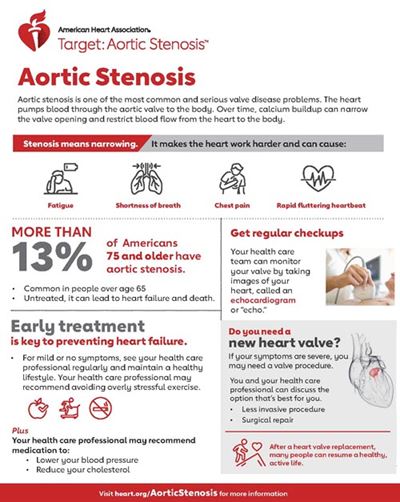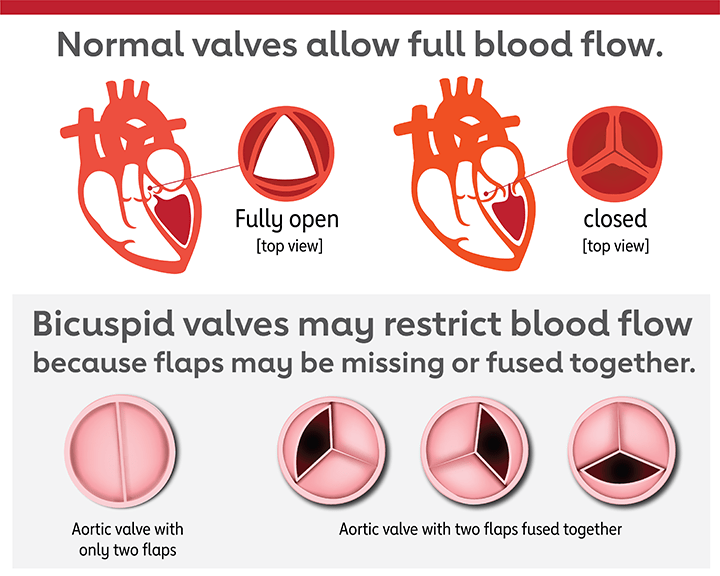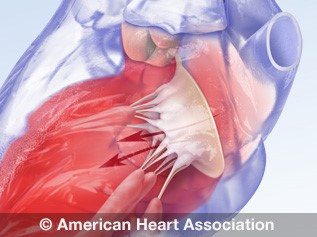Aortic Stenosis Overview
What is aortic valve stenosis?
Aortic stenosis is one of the most common and serious valve disease problems. Aortic stenosis is a narrowing of the aortic valve opening and can sometimes be referred to as a failing heart valve. Aortic stenosis restricts the blood flow from the left ventricle to the aorta may also affect the pressure in the left atrium.

Access our aortic stenosis fact sheet (PDF) | Spanish (PDF)
Does aortic stenosis always produce symptoms?
No. Many people with aortic stenosis, or AS, don't experience noticeable symptoms until the amount of restricted blood flow becomes greatly reduced.
Symptoms of aortic stenosis may include:
- Chest pain
- Rapid, fluttering heartbeat
- Trouble breathing or feeling short of breath
- Feeling dizzy or light-headed, even fainting
- Difficulty walking short distances
- Decline in activity level or reduced ability to do normal activities
It may be important to note someone with AS may not complain of symptoms. However, if you or your family members notice a decline in routine physical activities or significant fatigue, it’s worth a visit to your health care professional to check for reduced heart function. Use our AS symptom tracker (PDF) to record your symptoms and frequency, and bring it to your next appointment to review with your doctor.
Infants and children who have aortic stenosis due to a congenital defect may exhibit symptoms such as:
- Fatigue upon exertion
- Failure to gain weight
- Poor or inadequate feeding
- Breathing problems
Watch this short video about AS symptoms.
Watch an animation of aortic valve stenosis.
How does aortic stenosis progress or cause increasing problems?
In addition to the symptoms of aortic stenosis, which may cause a patient to feel faint, weak or lethargic, the wall of the left ventricle also may show muscular thickening because the ventricle must work harder to pump blood through the narrow valve opening into the aorta.
The thickened wall takes up more space inside the lower heart chamber and allows less room for an adequate amount of blood to be supplied to the body. This may lead to heart failure. Appropriate treatment can help reverse or slow down the progress of this disease.
Management and treatment of aortic stenosis is based on its cause and how advanced it is.
Aortic stenosis is classified into four major stages:
- Stage A: At risk of developing the condition
- Stage B: Obstruction of aortic valve blood flow is present and progressing
- Stage C: Severe obstruction is present but without symptoms
- Stage D: Severe obstruction is present with symptoms
Causes of aortic stenosis
Aortic stenosis mainly affects older people as a result of scarring and calcium buildup in the valve cusp (flap or fold). Age-related AS usually begins after age 60, but often it doesn’t show symptoms until ages 70 or 80.
It may also result from contracting rheumatic fever in childhood.
Aortic stenosis in the young
Bicuspid aortic valve is a birth defect where only two cusps grow instead of the normal three. This can lead to aortic stenosis.
Another cause may be that the valve opening doesn't grow along with the heart. This makes the heart work harder to pump blood to the restricted opening. Over the years the defective valve often becomes stiff and narrow because of calcium buildup.

What treatments are advisable for people with aortic stenosis?
If there are no symptoms or if symptoms are mild, the best course of action could be regular follow-up and monitoring to see if any symptoms develop or worsen.
However, anyone with aortic stenosis should be checked with an echocardiogram to determine treatment options.
Possible treatments may include medications, valve repair or valve replacement. It’s important to discuss options with your health care team to ensure you receive the most effective treatment possible.
Additional resources:
- Understanding Aortic Stenosis (PDF)
- Aortic Stenosis Fact Sheet (PDF) | Spanish (PDF)
- Aortic Stenosis Symptom Tracker (PDF) | Spanish (PDF)
- Aortic Stenosis Discussion Guide: Get the most out of your appointment (PDF) | Spanish (PDF)
- Aortic Stenosis: Considerations for Replacing Your Aortic Valve (PDF)
- Answers by Heart sheets:
- Print our handy pre-surgery checklist: Facing and Recovering from Major Surgery (PDF)(link opens in new window) | Spanish (PDF)








